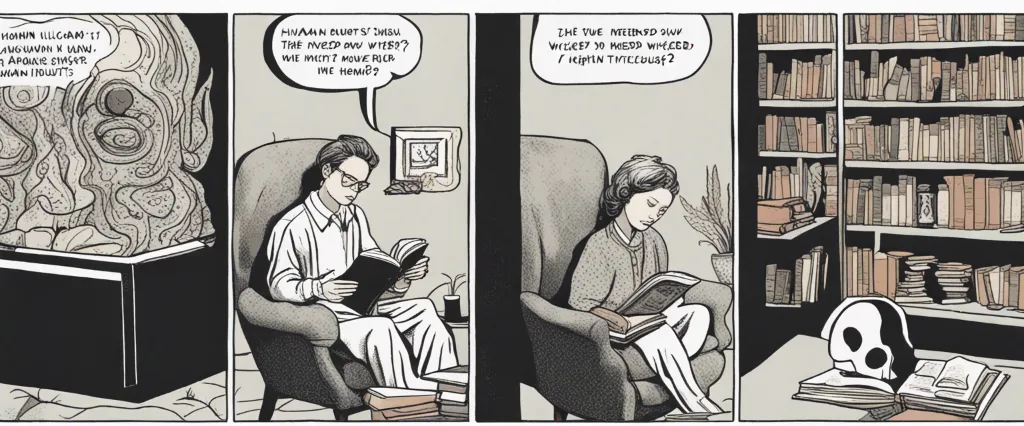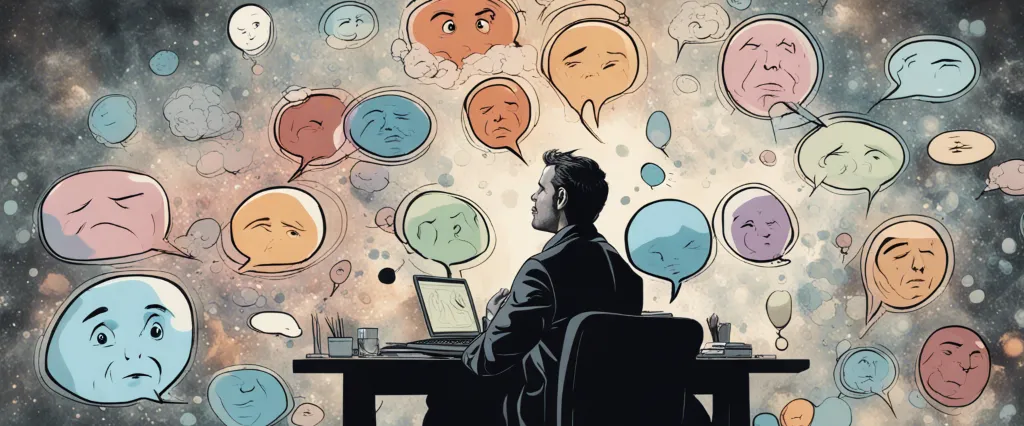In the groundbreaking book “A Billion Wicked Thoughts,” Sai Gaddam explores the hidden world of human sexuality through the lens of the internet. Gaddam, a neuroscientist and data scientist, ventures into the realm of human desires by examining billions of online searches and web page views. His unique research uncovers striking patterns, challenging traditional notions about sexuality, and shedding light on the vast diversity of human arousal. Embarking on an enlightening journey, Gaddam delves into the complexities of sexual preferences and urges, providing thought-provoking insights that reshape our understanding of human sexuality in the digital age.
Chapter 1: Revelations of Gender Psychology
Chapter 1 of “A Billion Wicked Thoughts” by Sai Gaddam is titled “Revelations of Gender Psychology” and provides an insight into the differences between men and women’s sexual desires, preferences, and behavior. The chapter presents a comprehensive understanding of human sexuality through an analysis of internet search data, highlighting fascinating patterns and tendencies.
The chapter begins by introducing the concept of “convergence,” suggesting that despite acknowledging individual differences, there are certain universal themes regarding sexual attraction that encompass both genders. However, the chapter mainly focuses on the “divergence” aspect, exploring the distinct psychological and biological aspects shaping men and women’s sexual preferences.
Gaddam emphasizes the role of evolutionary biology in understanding gender differences in sexuality. Women are found to be more selective due to the high investment necessary for pregnancy and child-rearing, typically seeking partners with characteristics indicative of resource abundance and stability. On the other hand, men are evolutionarily designed to pursue multiple partners as it increases their chances of reproductive success.
Using a variety of examples and research, Gaddam delves into the differences in sexual preferences between men and women. For instance, men tend to have a greater interest in visual and explicit sexual stimuli, while women are more responsive to emotional connections and relational context. The chapter also discusses the concepts of sexual novelty and variety, where men tend to seek diversity in partners and fantasies more than women.
Additionally, Gaddam addresses the intricacies of sexual orientation, highlighting the biological components involved. Studies indicate that individuals’ sexual orientations are predominantly innate rather than chosen, influenced by genetic factors and prenatal hormonal exposure.
In conclusion, Chapter 1 of “A Billion Wicked Thoughts” provides an engaging exploration of gender psychology related to sexuality. It offers an intriguing analysis of the factors influencing male and female sexual preferences, instinctual behaviors, and evolutionary adaptations. By analyzing internet data, the chapter presents a unique and comprehensive understanding of human sexuality, shedding light on both the similarities and differences between men and women.
Chapter 2: Exploring Sexual Desires in the Internet Age
Chapter 2 of “A Billion Wicked Thoughts” by Sai Gaddam explores the vast landscape of sexual desires in the Internet age. The chapter delves into the nature of sexual fantasies, how they are influenced by the digital world, and the differences in preferences between men and women.
The chapter begins by highlighting the wealth of data available about people’s sexual desires through online search data, which provides valuable insights into human sexuality. It points out that men’s sexual interests are largely visual, focusing on a wide range of physical attributes such as breasts, buttocks, and genitalia. On the other hand, women tend to be more responsive to context, looking for emotional connections and focusing on interpersonal relationships to fuel their fantasies.
The concept of “sexual orientation” is explored, challenging traditional notions that it is solely based on gender preferences. The analysis suggests that people’s sexual arousal is more fluid, differing based on specific attributes or scenarios rather than fixed preferences. The data also reveals intriguing patterns, such as women showing interest in homosexual male fantasies, which challenges gender norms.
The chapter further explores the role of pornographic content in shaping sexual desires. It argues that while porn can influence individual fantasies, it often reflects established preferences and desires rather than creating new ones. Additionally, the online world allows people to explore diverse and niche desires, fostering acceptance and understanding among sexual communities.
Overall, Chapter 2 delves into the vast and multifaceted world of sexual desires in the Internet age. It sheds light on the fluidity of sexual orientation and preferences, challenges gender norms in sexual fantasies, and emphasizes the role of the internet in expanding and accepting diverse sexual interests.
Chapter 3: Gender Differences and Sexual Orientations
Chapter 3 of “A Billion Wicked Thoughts” by Sai Gaddam delves into the exploration of gender differences and sexual orientations. The chapter attempts to analyze the vast amount of data collected from online sources such as search engines, adult websites, and social media platforms to provide insights into the sexual behavior of individuals.
One of the key findings discussed in this chapter is the differences between men and women when it comes to sexual preferences. The data reveals that men are generally more attracted to visual stimuli, such as explicit imagery, while women tend to be more responsive to contextual cues, such as emotions and relationships. This finding challenges traditional stereotypes regarding male and female sexuality.
Furthermore, the chapter examines how sexual orientation affects people’s preferences. It argues that sexual orientation is not just a binary concept but exists along a spectrum. The data shows that individuals who identify as gay or lesbian often exhibit distinct patterns of interest and behavior compared to heterosexual individuals. For instance, gay men tend to show a higher interest in specific sexual acts, whereas lesbians display more diverse sexual interests.
The chapter also explores the concept of bisexuality, which challenges the notion of a completely binary sexual orientation. It discusses the idea that bisexuality may have different patterns of interest and behavior compared to monosexual orientations, and highlights the complexity of studying sexual behavior.
Overall, Chapter 3 provides a fascinating analysis of gender differences and sexual orientations using extensive online data. It challenges traditional notions of sexuality and provides valuable insights into the diverse sexual interests and preferences of individuals across various gender identities and orientations.
Chapter 4: The Influence of Social and Cultural Factors on Sexuality

Chapter 4 of “A Billion Wicked Thoughts” titled “The Influence of Social and Cultural Factors on Sexuality” explores how societal and cultural aspects shape human sexuality. The chapter focuses on examining how factors such as religion, media, and gender roles impact sexual preferences and behaviors.
Religion plays a significant role in shaping sexual attitudes and behaviors. The authors discuss how different religious beliefs influence individuals’ views on sex, intimacy, and the role of women, thereby affecting their sexual behaviors and decision-making. For instance, religious conservatism often promotes abstinence and restricts sexual exploration outside of traditional marriage, while other religions may embrace more liberal attitudes towards sex.
The media is also a powerful influence on our sexual preferences. The authors analyze the portrayal of sexual content in media, such as pornography, and how it affects individuals’ desires and expectations. They highlight how exposure to explicit content influences sexual fantasies and shapes the ways people seek pleasure.
Furthermore, the chapter explores the impact of gender roles on sexuality. Cultural expectations often assign specific roles and responsibilities to each gender, influencing how they perceive and act upon their desires. The authors discuss how societal norms regarding masculinity and femininity impact sexual behavior, including the pressure on men to be dominant and women to be submissive.
Overall, the chapter emphasizes how social and cultural factors mold our sexual attitudes and behaviors. It sheds light on the complex interplay between religious beliefs, media exposure, and gender roles, highlighting their influence on sexuality throughout different societies and cultures. Understanding these influences is crucial to appreciating the diversity and complexity of human sexuality.
Chapter 5: Internet Pornography and Sexual Fantasies
Chapter 5 of “A Billion Wicked Thoughts” by Sai Gaddam explores the topic of internet pornography and sexual fantasies. The chapter delves into how the internet has revolutionized the way people consume and explore sexually explicit content.
The chapter begins by highlighting the widespread availability and anonymity that the internet offers in accessing pornography. It describes how individuals from various backgrounds, age groups, and genders engage with online adult content. The authors analyze vast amounts of internet search data to uncover patterns and preferences in sexual fantasies.
Gaddam explains that men and women tend to have different sexual interests. Men tend to gravitate towards visual stimuli, seeking explicit and often taboo content. They are more aroused by a wide range of sexual variations and are more likely to explore multiple fantasies. On the other hand, women tend to be more selective, looking for realistic contexts and emotional connections within their fantasies.
The authors also discuss the prevalence of certain sexual fantasies, such as domination and submission, incest roleplay, and voyeurism, and provide explanations from an evolutionary psychology perspective. They argue that these fantasies are not necessarily indicative of real-life desires or behaviors but are rather a manifestation of the brain’s natural tendency to explore multiple possibilities.
Additionally, the chapter explores the potential effects of pornography consumption, discussing whether it leads to addiction or desensitization. Gaddam stresses the importance of recognizing individual differences in responses to pornography and emphasizes the need for more research in this area.
In summary, Chapter 5 of “A Billion Wicked Thoughts” presents an in-depth analysis of internet pornography and sexual fantasies. It provides insights into the differences between male and female preferences, explores prevalent sexual fantasies, and tackles the potential effects of pornography consumption, ultimately encouraging further research on the subject.
Chapter 6: An Evolutionary Perspective on Human Sexual Behavior
Chapter 6 of A Billion Wicked Thoughts, titled “An Evolutionary Perspective on Human Sexual Behavior,” examines the evolutionary roots of human sexual behaviors and preferences. The authors, Sai Gaddam and Ogi Ogas, delve into the role of evolution in shaping human mating strategies, desires, and the evolutionarily inspired theories surrounding gender differences in sexuality.
The chapter starts by emphasizing that evolution drives human sexual desires and behavior, as our ancestors’ reproductive success depended on successful mating strategies. The authors discuss how men and women, due to their different reproductive investments, have developed distinct sexual strategies throughout evolutionary history. Men tend to focus on seeking multiple partners to increase their chances of genetic success, while women prioritize quality partners who can provide resources and protect their offspring.
The authors delve into several theories that have emerged from evolutionary psychology, seeking explanations for various sexual behaviors. These include theories like sperm competition, ovulation concealment, sexual jealousy, and sexual dimorphism. By examining these theories, the authors shed light on how evolution has shaped human attraction, jealousy, and mate selection.
The chapter also discusses how evolutionary biology has influenced societal norms, such as the emphasis on physical appearance, youth, and fertility in mate selection. It explores how evolutionary forces have shaped human preferences for specific physical traits, such as facial symmetry or waist-to-hip ratio.
Overall, Chapter 6 of A Billion Wicked Thoughts provides a comprehensive overview of the evolutionary underpinnings of human sexual behavior. It highlights how understanding our evolutionary roots can shed light on present-day sexual desires and preferences, as well as the societal norms that have emerged as a result.
Chapter 7: Gender Roles and Sexual Behaviors
Chapter 7 of the book “A Billion Wicked Thoughts” by Sai Gaddam focuses on the exploration of gender roles and sexual behaviors. The chapter delves into various aspects, including the evolution of human mating strategies, the differences between male and female sexual desires, and the influence of gender roles on sexual behavior.
The chapter begins by discussing the differences in mating strategies between males and females, emphasizing the evolutionary need for reproductive success. It highlights that historically, men sought multiple sexual partners to maximize their chances of passing on their genes, whereas women sought partners who could provide resources and support for their offspring.
Gaddam then examines the impact of gender roles on contemporary sexual behaviors. He delves into societal expectations and norms surrounding masculinity and femininity, which shape individuals’ sexual preferences and desires. For instance, men are often expected to be dominant and assertive in sexual encounters, while women are expected to be submissive and nurturing. These traditional roles can influence the way men and women perceive and engage in sexual activities.
The chapter also unveils the complexities of sexual desires, addressing the popular belief that men have a higher sex drive than women. By drawing on research and statistical data, Gaddam highlights that women’s sexual desires are just as potent as men’s, although they may manifest in different ways due to social constraints.
Additionally, the chapter discusses the effects of pornography on gender roles and sexual behaviors. Gaddam argues that pornography can reinforce traditional gender stereotypes, portraying women in submissive roles and men as dominant. Such depictions can shape individuals’ expectations, influencing their sexual experiences and desires.
Overall, Chapter 7 of “A Billion Wicked Thoughts” provides a comprehensive examination of gender roles and sexual behaviors, emphasizing the influence of evolutionary factors, societal expectations, and media influence. It challenges conventional beliefs and offers insight into the complexities of human sexuality.

Chapter 8: Sexuality and Mental Well-being
Chapter 8 of “A Billion Wicked Thoughts” by Sai Gaddam explores the intricate relationship between sexuality and mental well-being. The authors analyze a vast amount of data collected from online sources, including search engine queries and social media posts, to delve into various aspects of human sexual behavior and their impact on mental health.
The chapter begins by focusing on the concept of sexual orientation and how it affects mental well-being. The authors demonstrate that individuals who identify as homosexual or bisexual are more likely to face challenges related to mental health, such as higher rates of depression and anxiety. They also highlight social factors, such as discrimination and stigmatization, that contribute to these disparities.
The authors then delve into the psychological aspects of sexual fantasies and their role in mental well-being. They reveal that individuals who engage in diverse, unconventional, or taboo fantasies tend to exhibit better mental health outcomes. This suggests that allowing oneself to explore a broad range of sexual thoughts can be beneficial, as long as it remains within the limits of consent and legality.
Furthermore, the authors address the impact of sexual satisfaction on mental well-being. They find that sexual contentment contributes significantly to overall happiness and life satisfaction. This highlights the importance of maintaining a healthy and fulfilling sexual life for positive mental health outcomes.
Lastly, the chapter explores the relationship between mental health and sexual behavior in non-heteronormative individuals. The authors shed light on the unique challenges faced by transgender individuals and how societal acceptance and access to gender-affirming treatments play a crucial role in their mental well-being.
Overall, Chapter 8 of “A Billion Wicked Thoughts” presents a comprehensive analysis of how sexuality intersects with mental well-being. It emphasizes the significance of understanding and embracing diverse sexual orientations, fantasies, and behaviors within a consensual and open-minded framework to promote positive mental health outcomes.
After Reading
In conclusion, “A Billion Wicked Thoughts” by Sai Gaddam is an insightful exploration into human sexuality and desires through the lens of internet data analytics. The book highlights the vast range of sexual interests and fantasies, challenging traditional assumptions and shedding light on the complexity of human sexual behavior. Gaddam’s collaboration with Ogi Ogas and their analysis of billions of online searches and forums provides valuable insights into our collective desires and preferences. By dissecting the diverse landscape of sexual fantasies, the authors unravel societal taboos, promote understanding, and encourage open conversations about human sexuality. “A Billion Wicked Thoughts” is an eye-opening read that combines scientific research and social commentary, ultimately inviting readers to question preconceived notions and embrace the diversity of sexual expression in today’s world.
1. “Dataclysm: Who We Are (When We Think No One’s Looking)” by Christian Rudder – This book, similar to “A Billion Wicked Thoughts,” delves into the world of human behavior and sexuality through analyzing big data. Rudder uses data from social media, online dating platforms, and more to shed light on the hidden patterns and preferences of modern society.
2. “The Secret Life of the Mind: How Your Brain Thinks, Feels, and Decides” by Mariano Sigman – Exploring the mysteries of the human mind, Sigman dives into the fascinating world of neuroscience. Through captivating anecdotes and scientific insights, he examines how our brains shape our thoughts, emotions, and decision-making processes.
3. Subliminal: How Your Unconscious Mind Rules Your Behavior” by Leonard Mlodinow – For readers intrigued by the subconscious and its influence on our daily lives, Mlodinow offers a captivating exploration. With a mix of science and psychology, he reveals how our unconscious thoughts and desires guide our actions, often without our awareness.
4. The Red Queen: Sex and the Evolution of Human Nature” by Matt Ridley – Ridley, similar to “A Billion Wicked Thoughts,” takes an evolutionary perspective on human mating behaviors. Exploring the role of sex and attraction in our species’ survival, he offers an insightful analysis of the biological underpinnings of human relationships.
5. Predictably Irrational: The Hidden Forces That Shape Our Decisions” by Dan Ariely – Examining the irrational behaviors and biases that shape our decision-making processes, Ariely provides readers with an engaging look into the psychology of human choice. With examples from various aspects of life, including relationships, he reveals the often unexpected ways our minds function.




